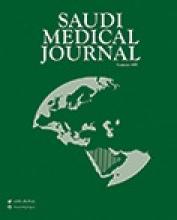Abstract
OBJECTIVE: To determine the potential risk factors for retinal detachment after cataract surgery.
METHODS: In this retrospective cohort study, medical records of patients operated on between 2000 and 2010 at the Department of Ophthalmology, King Abdulaziz University Hospital, Riyadh, Kingdom of Saudi Arabia were retrospectively reviewed for both demographic and clinical data. Cases were identified as having an ocular axial length >/=25 mm, while a control group of 500 eyes (axial length range; 22-24 mm) was sampled. Data were analyzed to compare both groups, and to assess potential risk factors for post-cataract retinal detachment.
RESULTS: We reviewed 852 eyes of 721 patients; 352 eyes with documented high myopia were compared with 500 control eyes. After a mean follow up of 45.1 +/- 27.9 months, the postoperative mean LogMAR visual acuity significantly differed; 0.51 +/- 0.48 for cases and 0.38 +/- 0.41 for controls (p<0.0001). Controls showed significantly better postoperative vision as measured by LogMAR (0.92 +/- 0.7) than cases (0.71 +/- 0.61) (p<0.0001). Twelve eyes (1.4%) had retinal detachments postoperatively. The RD prevalence was significantly higher among cases (10 [2.8%]) than controls (2 [0.4%]) (p=0.007). High axial length was the only significant risk factor for retinal detachment (p=0.005) even after multivariate adjustment (p=0.019).
CONCLUSION: High axial length among myopic cataract patients may increase the risk of postoperative retinal detachment.
- Copyright: © Saudi Medical Journal
This is an open-access article distributed under the terms of the Creative Commons Attribution-Noncommercial License (CC BY-NC), which permits unrestricted use, distribution, and reproduction in any medium, provided the original work is properly cited.






